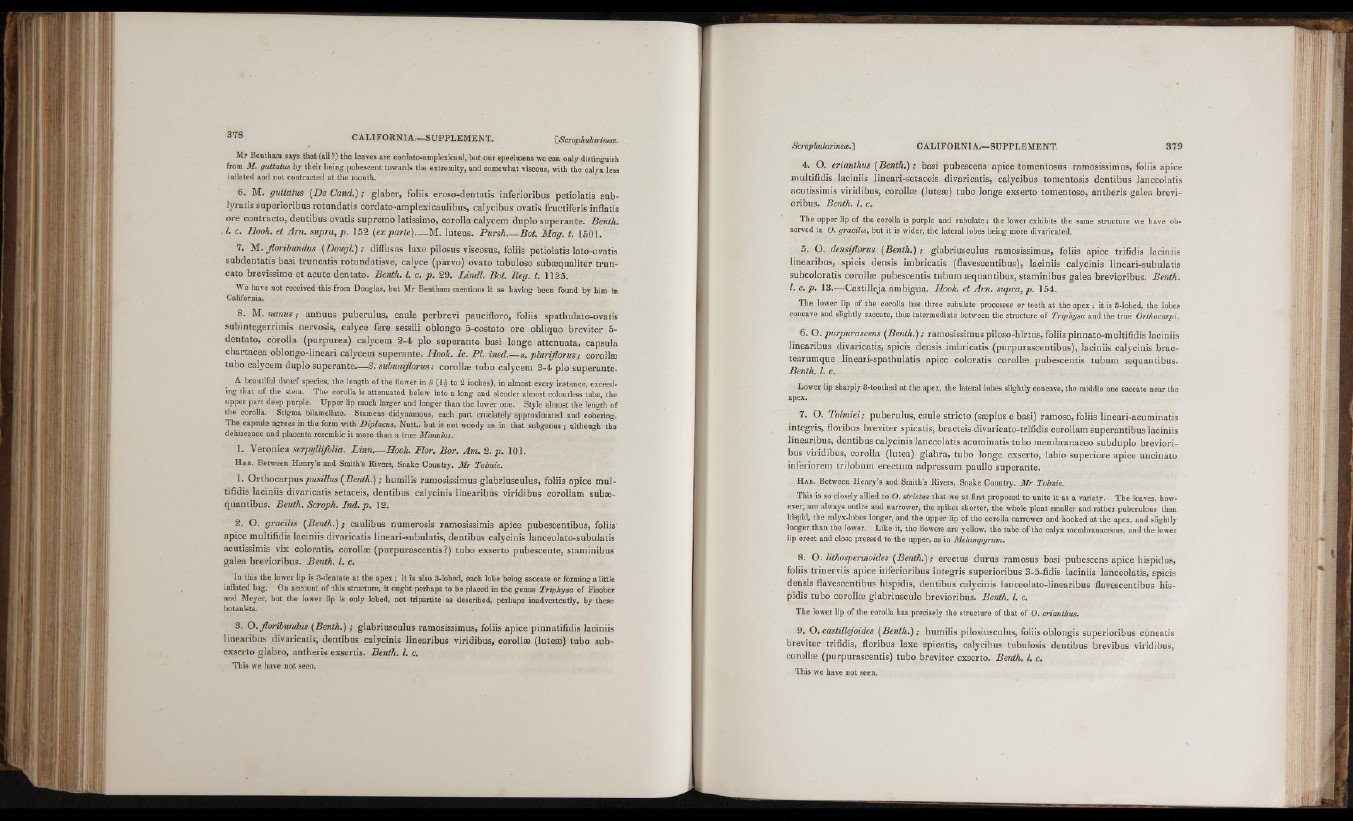
Mr Bentham says that (all ?) the leaves are cordato-amplexicaul, but our specimens we can only distinguish
from M. guttatus by their being pubescent towards tbe extremity, and somewhat viscous, with the calvx less
inflated and not contracted at the mouth.
6. M- gutiatus (De Cand.) ; glaber, foliis eroso-dentatis inferioribus petiolatis sublyratis
superioribus ro tundatis cordato-amplexicaulibus, calycibus ovatis fructiferis inflatis
o re co n trac te , dentibus ovatis supremo latissimo, corolla calycem duplo superante. Benth.
I. c. Hook, et A rn . supra, p . 152 {ex p a rte)— M. luteus. P u r sh Bot. Mag. t. 1501.
7. Nl. floribundus (D o u g l) ; diffusus laxe pilosus viscosus, foliis petiolatis lato-ovatis
su bdentatis basi trunca tis rotundatisve, calyce (parvo) ovato tubuloso subæqualiter tru n cato
brevissime e t acute d enta to. Benth. I c. p . 29. L in d l. Bot. Reg. t. 1125.
We have not received this from Douglas, but Mr Bentham mentions it as having been found by him in
California.
8. M . nanus ; annuus puberulus, caule p e rb rev i paucifloro, foliis spathulato-ovatis
subintegerrimis nervosis, calyce fere sessili oblongo 5-costato ore obliquo breviter 5-
denta to, corolla (p u rp u re a ) calycem 2-4 pio su p eran te basi longe a tten u a ta , capsula
ch arta cea oblongo-lineari calycem superante. Hook. I c . PI. ined.— a. plurifiorus; corollæ
tubo calycem d uplo su p eran te— Q.subunifiorus; corollæ tubo calycem 3-4 pio superante.
A beautiful dwarf speeies, the length of the flower in fi (U to 2 inches), in almost every instance, exceed-
mg that of the stem. The corolla is attenuated below into a long and slender almost colourless tube, the
upper part deep purple. Upper lip much larger and longer than the lower one. Style almost the length of
the corolla. Stigma bilamellate. Stamens didynamous, each part cruciately approximated and cohering.
Tbe capsule agrees in the form with Diplacus, Nutt., but is not woody as in that subgenus ; although the
dehiscence and placenta resemble it more than a true Mimulus.
1. Veronica serpyllifolia. L in n .— Hook. Flor. Bor. Am. 2. p . 101.
Hab. Between Henry’s and Smith’s Rivers, Snake Country. M r Tolmie.
1. Orthocarpus pusillus {Benth.) ; humilis ramosissimus glabriusculus, foliis apice multifidis
laciniis divarieatis setaceis, dentibus calycinis linearibus viridibus corollam subæquantibus.
Benth. Scroph. In d . p . 12.
2. O. gracilis (B e n th .); caulibus numerosis ramosissimis apice pubescentibus, foliis
apice multifidis laciniis divarieatis lineari-subulatis, dentibus calycinis lanceolato-subulatis
acutissimis vix coloratis, corollæ (p urpurascentis?) tubo exserto pubescente, staminibus
galea brevioribus. Benth. I. c.
In this the lower lip is 3-dentate at the apex ; it is also 3-lobed, each lobe being saccate or forming a little
inflated bag. On account of this structure, it ought perhaps to be placed in the genus Triphysa of Fischer
and Meyer, but the lower lip is only lobed, not tripartite as described, perhaps inadvertently, by these
botanists.
3. O. floribundus (Benth.) ; glabriusculus ramosissimus, foliis apice pinnatifidis laciniis
linearibus divarieatis, dentibus calycinis linearibus viridibus, corollæ (luteæ) tubo subexserto
glabro, antheris exsertis. Benth. I. c.
This we have not seen.
4. O. erianthus (Benth.) ; basi pubescens apice tomentosus ramosissimus, foliis apice
multifidis laciniis lineari-setaceis divai-icatis, calycibus tomentosis dentibus IanceolatI.s
acutissimis viridibus, corollæ (luteæ) tubo longe exserto tomentoso, antheris galea brevioribus.
Benth. I. c.
The upper lip of the corolla is purple and subulate ; the lower exhibits the same structure we have observed
in O. gracilis, but it is wider, the lateral lobes being more divaricated.
5. O. densiflorus (Benth.) ; glabriusculus ramosissimus, foliis apice trifidis laciniis
linearibus, spicis densis imbricatis (flavescentibus), laciniis calycinis lineari-subulatis
subcoloratis corollæ pubescentis tubum æquantibus, staminibus galea brevioribus. Benth.
I. c. p . 13.— Castilleja ambigua. Hook, et A rn. supra, p . 154.
The lower lip of the corolla has three subulate processes or teeth at the apex ; it is 8-lobed, the lobes
concave and slightly saccate, thus intermediate between the structure of Triphysa and the true Orthocarpi.
6. O . purpurascens (Benth.)} ramosissimuspiloso-hirtus, foliispinnato-multifidis laciniis
linearibus divarieatis, spicis densis imbricatis (purpurascentibus), laciniis calycinis brac-
tearumque lineari-spathulatis apice coloratis corollæ pubescentis tubum æquantibus.
Benth. I. c.
Lower lip sharply 3-toothed at the apex, the lateral lobes slightly concave, the middle one saccate near the
apex.
7. O. Tolmiei; puberulus, caule stricto (sæpius e basi) ramoso, foliis lineari-acuminatis
integris, floribus breviter spicatis, bracteis divaricato-trifidis corollam superantibus laciniis
linearibus, dentibus calycinis lanceolatis acuminatis tubo membranaceo subduplo brevioribus
viridibus, corolla (lutea) g lab ra, tubo longe exserto, labio superiore apice uncinato
inferiorem trilobum erectum adpressum paullo superante.
H ab. Between Henry’s and Smith’s Rivers, Snake Country. M r Tolmie.
This is so closely allied to O. strictus that we at first proposed to unite it as a variety. The leaves, how-
ever, are always entire and narrower, the spikes shorter, the whole plant smaller and rather puberulous than
hispid, the calyx-Iobes longer, and the upper lip of the corolla narrower and hooked at the apex, and slightly
longer than the lower. Like it, the flowers are yellow, the tube of the calyx membranaceous, and the lower
lip erect and close pressed to the upper, as in Melampyrum.
8. O. lithospermoides (B en th .); erectus d u ru s ramosus basi pubescens apice hispidus,
foliis trinerviis apice inferioribus integris superioribus 3-5-fidis laciniis lanceolatis, spicis
densis flavescentibus hispidis, dentibus calycinis lanceolato-linearibus flavescentibus hispidis
tubo corollæ glabriusculo brevioribus. Benth. I. c.
The lower lip of the corolla has precisely the structure of that of O. erianthus.
9. O.castillejoides (Benth.) ; humilis pilosiusculus, foliis oblongis superioribus cuneatis
breviter trifidis, floribus laxe spicatis, calycibus tubulosis dentibus brevibus viridibus,
corollæ (purpurascentis) tubo breviter exserto. Benth. I. c.
This we have not seen.